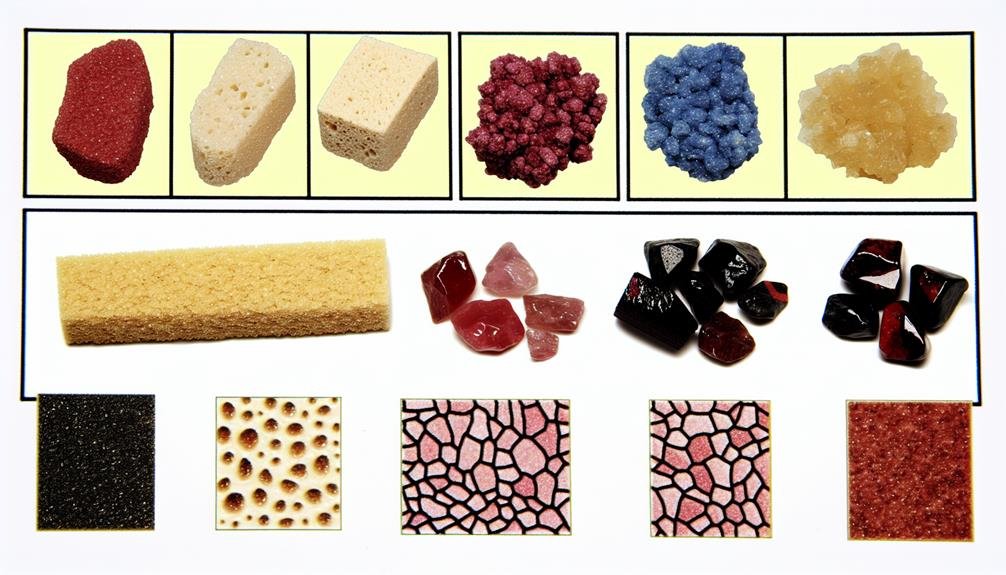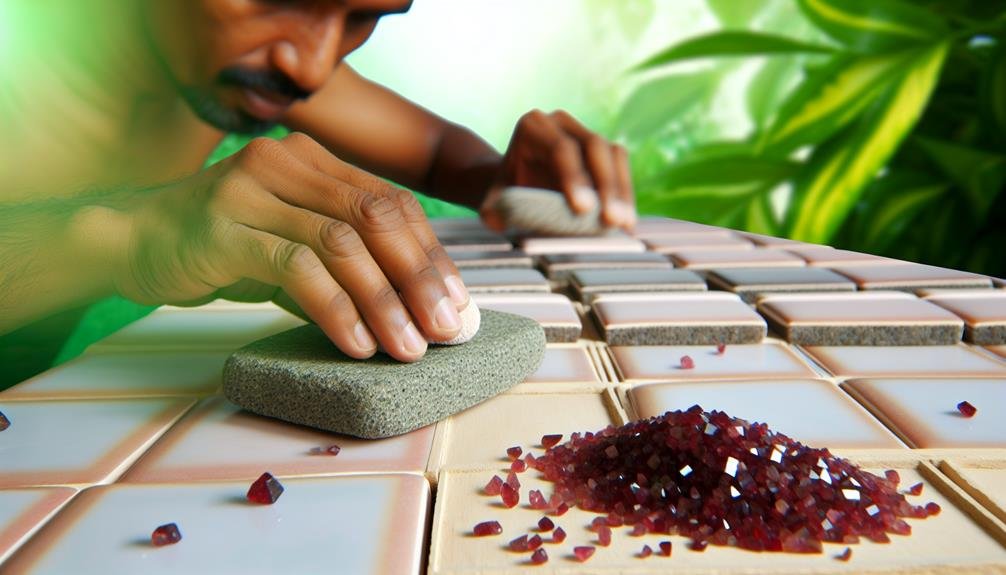In the realm of tile manufacturing, the shift towards sustainability prompts a reevaluation of traditional materials and methods, particularly in the area of abrasives used for tile grinding. Natural abrasive material, such as garnet, corundum, and diamond, offer intriguing alternatives due to their inherent properties that could potentially revolutionize surface finishing techniques. These materials not only provide environmental benefits but also enhance the efficiency and quality of tile production. However, the practical application of these natural abrasive material raises questions about their economic viability and performance consistency compared to synthetic options. An in-depth exploration of these materials could uncover opportunities to redefine industry standards while adhering to environmental sustainability goals.

Natural abrasive material, derived from geological processes, are essential materials used in the surface finishing and shaping of tiles. These substances are integral to numerous industrial applications, particularly in the tile manufacturing sector, where precision and control are paramount.
The inherent properties of natural abrasive material offer a unique balance of hardness and brittleness, which permits the meticulous modification of tile surfaces without compromising the integrity of the material.
Employing natural abrasive material in tile production not only enhances the aesthetic appeal of the final product but also ensures that the tiles meet exacting specifications required by the industry. This is crucial in applications where uniformity and standardization are critical, such as in flooring for high-traffic areas or decorative wall tiles in architectural projects.
The choice of a specific natural abrasive material and its application technique directly influences the durability, texture, and coloration of tiles, thus allowing manufacturers to achieve desired outcomes with high precision.
Understanding the characteristics and implications of using natural abrasive material is essential for manufacturers who aim to optimize their production processes and maintain control over the quality and consistency of their tile products. This knowledge serves as a foundation for making informed decisions that align with both technical requirements and market demands.

In exploring natural abrasive material used in tile grinding, it is essential to categorize these materials by their common types. Understanding the varying levels of hardness they possess is crucial for recognizing the range of grain sizes available. Each category plays a crucial role in determining the effectiveness and suitability of an abrasive for specific tile grinding applications.
Several types of natural abrasive material are commonly used in tile grinding, including garnet, corundum, and diamond. Garnet, a silicate mineral found in varying colors, is favored for its medium hardness and sharp edges, making it suitable for smoothing rough surfaces without excessive material removal.
Corundum, composed mainly of aluminum oxide, is harder and offers greater durability for more intensive grinding tasks. Its crystalline structure provides a robust cutting face ideal for processing tougher tile materials.
Diamond, the hardest naturally occurring material, stands out for its unparalleled grinding efficiency. Used primarily in professional settings, diamond abrasives deliver precise cuts and exceptional longevity, thereby reducing tool changeovers and downtime. This makes diamond an optimal choice for projects requiring high precision and minimal maintenance.
These abrasives are selected based on their unique properties and the specific requirements of the grinding task at hand. Professionals in the field utilize this knowledge to optimize outcomes, ensuring that the right abrasive is employed for the desired finish and efficiency.
This strategic selection aids in maintaining control over the grinding process, enhancing both the quality of the work and the productivity of the operation.
Understanding the hardness levels of natural abrasive material like garnet, corundum, and diamond is fundamental to selecting the appropriate material for specific tile grinding applications. Hardness not only determines the effectiveness of the grinding process but also impacts the longevity and wear resistance of the abrasive material. This characteristic is measured by the Mohs scale, where a higher number indicates a harder material.
Here is a concise table showcasing the hardness of some commonly used natural abrasive material:
| Abrasive Material | Mohs Hardness |
|---|---|
| Diamond | 10 |
| Corundum | 9 |
| Garnet | 6.5 - 7.5 |
| Quartz | 7 |
| Flint | 7 |
Selecting a harder abrasive generally results in more efficient material removal, as it can more easily penetrate harder tile surfaces. For instance, diamond, with a Mohs hardness of 10, is exemplary for grinding very hard tiles. Conversely, garnet, with its comparatively lower hardness, might be more suitable for softer or more delicate tiling materials.
For professionals aiming to optimize their grinding operations, understanding these hardness levels allows for more controlled and precise material handling, ensuring both efficiency and quality in the final surface finish.
Grain size in natural abrasive material, ranging from fine to coarse, critically influences the efficiency and finish quality of tile grinding processes. The selection of grain size must be meticulously matched to the specific requirements of the tile material and the desired finish. Fine grains are typically used for achieving a smooth, polished surface, while coarse grains are suited for rapid material removal and initial shaping.
In the context of natural abrasive material such as garnet, pumice, and emery, understanding the granulometry—distribution and size of the abrasive particles—is essential for optimizing the grinding operation. Garnet, for instance, is available in micro sizes for precision finishing, which is crucial for delicate ceramic tiles. Conversely, pumice, with its softer composition and larger grain sizes, is more appropriate for gentle surface cleaning rather than aggressive grinding.
To ensure consistency and control over the grinding process, it is advisable to use graded abrasives. These materials have been processed to maintain uniform particle sizes, which helps in reducing tile surface defects and enhances the predictability of the grinding results.

Natural abrasive material offers significant advantages in tile grinding due to their environmental friendliness and cost-effectiveness. These materials, sourced from the earth, provide a level of utility that is both practical and beneficial for precise and controlled tile shaping processes.
Utilizing natural abrasive material such as garnet, pumice, or emery allows for a meticulous approach to achieving desired surface textures and shapes, an essential component in the craftsmanship of tiling.
Moreover, the inherent properties of natural abrasive material contribute to their efficiency. Their variable hardness and brittleness can be judiciously selected to match specific grinding requirements, which empowers professionals to tailor their approach to each unique project. This customization capability ensures that the abrasive action is neither too harsh nor too mild, thereby optimizing the quality of the finish and minimizing tile wastage.
The reliability of natural abrasive material also stands out. These materials have been used historically for various grinding and polishing tasks, proving their durability and consistency across different applications.
For tile manufacturers and renovators, the predictable performance of natural abrasive material translates into streamlined operations and reduced risk of error, providing a significant control advantage in production environments.

As we assess the environmental impacts of natural abrasive material, it is crucial to consider their ecological footprint. This involves evaluating how their extraction and usage affect global resources and energy consumption.
Additionally, understanding their effects on biodiversity provides insight into the broader ecological consequences of their utilization in tile grinding.
Evaluating the ecological footprint of various abrasives reveals significant differences in their environmental impacts during the tile grinding process. Understanding these differences is crucial for industries aiming to minimize their environmental burden while maintaining control over their production methods.
The following list provides a structured comparison of key factors:
Understanding the impact of abrasives on biodiversity further adds to the complexity of choosing environmentally responsible materials for tile grinding. Biodiversity, the variety and variability of life forms within a given ecosystem, can be significantly affected by the extraction and use of natural abrasive material. Each abrasive material, whether garnet, pumice, or silica sand, originates from specific environments that host unique ecosystems. The extraction processes can lead to habitat destruction, alteration of landforms, and can disrupt local flora and fauna, potentially leading to decreased biodiversity.
A responsible approach involves evaluating the direct and indirect effects of abrasive extraction on surrounding ecosystems. This analysis includes assessing species displacement, water pollution, and soil degradation that could result from abrasive mining activities.
Furthermore, the sustainability of these materials depends not only on their environmental impact but also on their availability and renewability. For instance, while silica sand is abundant, its extraction can lead to significant environmental degradation if not managed properly.
Exploring the practical applications of natural abrasive material in tile grinding reveals their essential role in achieving precise and smooth finishes. The meticulous process of shaping and finishing tiles demands materials that can offer both precision and efficiency.
Natural abrasive material, derived from geological environments, is particularly valued for their inherent properties, which cater to various aspects of tile grinding. These applications include:
These applications underscore the versatility and efficacy of natural abrasive material in managing the complex requirements of tile grinding.
As we look toward the future, advancements in abrasive technology promise to further enhance the efficiency and sustainability of tile grinding processes. The development of ultra-durable materials and precision-engineered particles is anticipated to revolutionize the industry. Researchers are focusing on synthesizing abrasives that maintain an optimal balance between hardness and brittleness to reduce wear and extend the lifespan of grinding tools.
Emerging trends also include the integration of smart technology in abrasives, which allows for real-time monitoring and adjustments during the grinding process. This innovation enables unprecedented control over particle size and distribution, ensuring more uniform surfaces with minimal material waste.
Additionally, the push towards environmentally friendly materials continues to gain momentum. Future abrasives are likely to be derived from sustainable sources, with improved recyclability and reduced environmental impact.
Such advancements will not only elevate the performance and cost-effectiveness of tile grinding but also enhance operational control. By adopting these innovative materials and technologies, manufacturers can expect to see significant improvements in production speed and quality, while also adhering to stricter environmental standards.
Natural abrasive material can significantly influence the speed of tile grinding, offering varying levels of efficiency based on their hardness and grit size. Optimal selection enhances productivity while minimizing damage to the tile surface.
Yes, natural abrasive material can effectively be used for polishing tiles. They offer a balance between abrasiveness and gentleness, ensuring a smooth finish without damaging the tile surface. Suitable options include pumice and garnet.
In the realm of natural abrasive material, while their efficacy in surface refinement is notable, potential health risks such as respiratory issues from inhalation of fine particles must be rigorously evaluated and managed.
Natural abrasive material often presents a more cost-effective alternative to synthetic abrasives due to their abundance and lower production costs. However, long-term affordability may vary based on resource availability and market demand.
When utilizing natural abrasive material, safety measures are paramount. Protective eyewear and respirators are essential to shield against particles. Regular equipment checks and adherence to operational guidelines further ensure user safety and control.
In conclusion, the juxtaposition of natural abrasive material against synthetic counterparts underscores their significant advantages in tile grinding.
Natural abrasive material like garnet and diamond offer superior sustainability and environmental benefits without compromising on performance.
As the industry progresses, these materials not only promise enhanced efficiency and cost-effectiveness but also pave the way for future innovations in abrasive technology, thereby sustaining ecological balance while advancing industrial capabilities in tile manufacturing.
